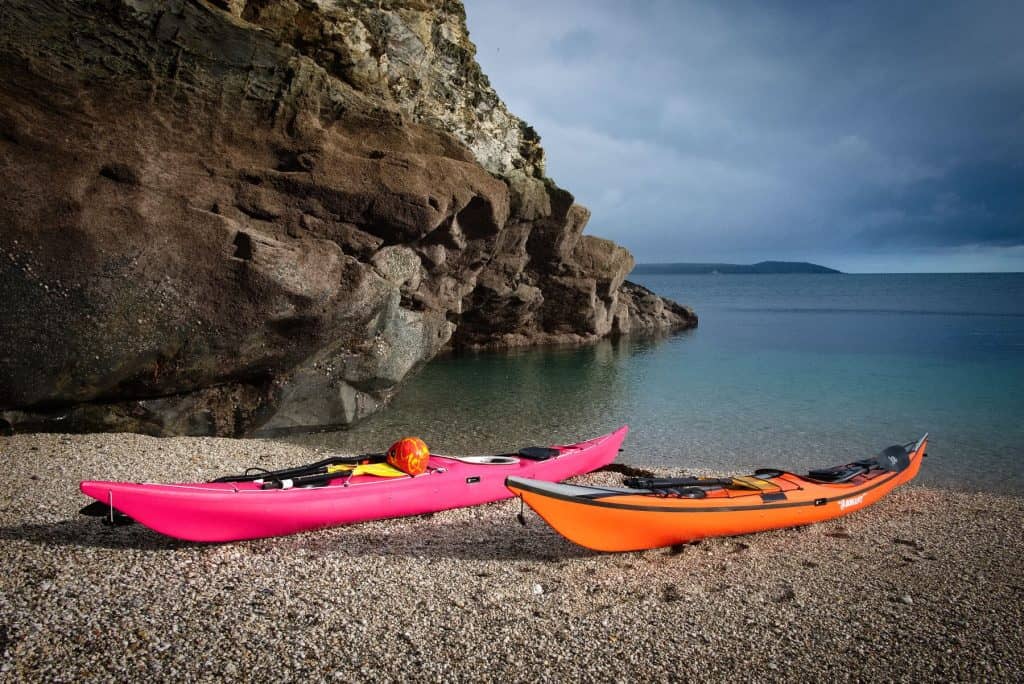
To get the fundamentals right, start by thinking about what sort of paddling you like to do most of the time. Of course, you can use pretty much any sea kayak from the Sea Kayaking UK range for most activities on the sea but some have been designed to excel in certain areas.
Primary Use
If you are going to vary your fun on the sea and want one kayak that “does it all” then choose a good all-rounder. If you mainly like to play in surf and around rocks, a boat that is easy to turn and with good stability is likely to be best. A faster kayak with plenty of space for equipment will be needed for expeditions.
Think about hatch sizes and the volume of each compartment – what do you need to carry? What will you need to access whilst on the water? Does the kayak have a day hatch that you can easily reach and that is big enough to contain all necessary equipment at sea?
If you are working through British Canoeing Personal Performance Awards you’ll need a sea kayak that enables you to demonstrate your skills with confidence. The ability to roll is likely to be important. Leaders, guides and coaches often have additional requirements as they carry extra kit that needs to be easily accessible.
Comfort and sizing
Probably the most important aspect is personal comfort. It’s quite normal for a paddler to spend several hours without a break in a sea kayak and you need to be sure it is right for you. It’s really not necessary to be tightly fitted into a sea kayak all day long. You only need to “lock in” when you encounter agitated sea conditions such as surf or tidal races. It’s better to be free to move around a little inside the kayak most of the time. It will help to keep the blood flowing. The high-performance seats fitted in NDKs help to tilt the pelvis forward. This fees the pelvis from the spine a little which allows your core to rotate more easily. Your forward paddling becomes more efficient.
Size matters, and so does shape. People have frames that are of different proportions, especially hips, leg lengths and waist to shoulder heights. You will almost certainly find a kayak in the Sea Kayaking UK range that is comfortable. Each demo day is structured to provide enough time to check key factors including seat sizes, footrest positions and thigh brace positions. We can also make minor modifications to improve comfort and connectivity using closed-cell foam padding.
Take some time to read and understand the technical specification of the kayak your are thinking of buying. Remember to check lengths (for storage) and weights (loading onto roof racks or carrying). Find out as much as you can from online sources and ask other paddlers about their own experiences.
Good manners
When I talk about manners, I’m referring to how the kayak reacts in wind and waves. Ideally, a sea kayak should turn gently towards the wind unaided. However, turning away from the wind should also be easy to achieve. Just use your body position (lean back) and place a paddle blade in the water a little behind your hips. This immerses a little more of the stern (back) of the kayak. At this point, the wind will have a greater affect on the bow (front). So it pushes the bow around and helps to point you to where you want to go. Now you can understand why the balance of your kayak will change if you move the seat at all.
Some manufacturers have designed and built sea kayaks that look modern and contemporary but in action can behave unpredictably. Sea Kayaking UK doesn’t allow seaworthiness to be compromised by fashion. All their kayaks are designed to be well balanced in all conditions. Most kayaks are okay in flat water and light wind conditions. A well-mannered kayak will look after you when it gets bouncy.
Stability is another expression widely discussed – both primary and secondary. Primary stability is a way of describing how “wobbly” (or not) a sea kayak feels when it’s upright and in calm conditions. Secondary stability describes how the sea kayak feels when placed “on edge” by the paddler – for example during a turn, or in moving water. For most people, a progressive change in stability is the easiest to work with. In very rough water and in the hands of an expert paddler, it’s arguable that the “on-off” stability transition of a hard-chine kayak will provide greater responsiveness.
Construction
Make sure your kayak is strong enough for the purpose you want to use it for. Check reviews on the web, in magazines and ask other paddlers. Ensure the materials used and the construction method are conventional. Repairs can become expensive if the kayak is made from unusual materials and you are forced to use specialists if you damage it. If the kayak develops a manufacturing defect, can it be sent to the factory for repair and at what cost? If the manufacturer is based in another country that can prove difficult or even impossible.
Once you’re sure that you’ve understood the fundamentals it’s time to get in touch and try out the one you think is for you!
